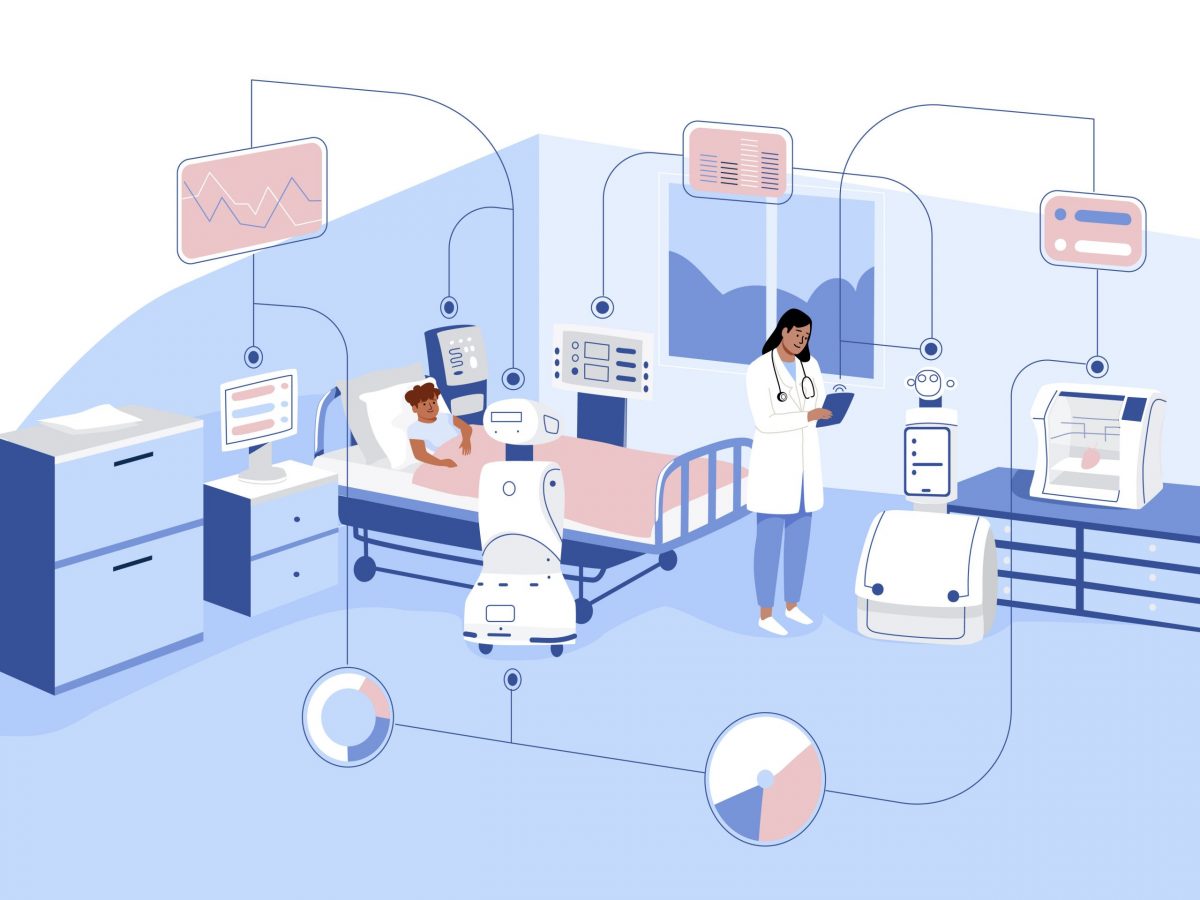
Healthcare needs are getting more complex, and systems more stretched. To meet the demand for precision healthcare, hospitals need to evolve to become smarter and more efficient. The World Health Organization (WHO) estimates healthcare will face a shortfall of 10 million healthcare workers worldwide by 2030. Is it sustainable to increase the workload of already stretched practitioners? Smart hospitals could make healthcare work more efficient and improve the quality of patient care.
Smart hospitals and the rise of e-health
Smart hospitals are part of the e-health phenomenon. A smart hospital improves patient care using optimized and automated processes, particularly the Internet of Things (IoT), to connect medical devices to AI and data analysis. Smart tech helps healthcare practitioners focus on providing high-quality care while reducing the barriers associated with using complex medical technology.
Smart tech means smarter workflows
One figurehead of the smart hospital movement is Humber River Valley Hospital, Canada. It’s North America’s first fully-digital hospital (think: online appointment scheduling, digital check-ins and your test results emailed.) It boasts robots and other tech to automate almost 80 percent of its back-office services like pharmacy, laundry and food delivery. This gives clinical staff more time to give back to patients.
SECURE FUTURES
What's coming next?
Be first to find out what’s happening in tech, leadership and cybersecurity.
Cleveland Clinic Abu Dhabi (CCAD,) UAE, uses digital apps to support treatments. Pre-treatment, patients use apps to communicate with staff. During their stay, they use smart pads to access their info, daily plans and order food. At discharge, the app sends prescriptions to local pharmacies then sends them their bill. Neat.
Can robots become care workers?
Smart tech could help meet labor shortages: this means more android helpers. During the first COVID-19 outbreak, Wuhan Hospital, China, was staffed entirely by robots for several days. Produced by start-up CloudMinds Technology, they improved patient care and gave respite to over-stretched workers.
Smart hospitals can automate and digitize traditional, labor-intensive processes. When healthcare is delivered quicker and more accurately, more people can be treated safer and quicker. Consider Johnson Control’s Code Blue Activation system; When a patient reaches critical condition, it calls up an emergency care team in just 24 seconds.
Could 3D printing replace donors?
There’s a relatively new tech in smart hospitals: 3D printing. Imagine the opportunities if surgical teams could print body parts, like prosthetic limbs or dental implants, on-demand. While the tech is in its infancy, there are promising advancements, though it’s without the speed and capabilities needed for large-scale adoption.
Engineers and medical researchers from the University of Minnesota recently created silicon-made scaffolding’ that could benefit those with spinal cord injuries by restoring muscle control. Cells are printed onto the structure then implanted into the patient’s spinal cord, with a bridge between cells.
Can smart hospitals save lives?
Given increased healthcare demands, hospitals may not have any choice but to change. Smart hospitals could improve the care we deliver and benefit our societies. But it will be a group effort.
Professor Daniel Kelly, Cardiff University’s School of Healthcare Sciences, thinks smart hospitals will be crucial for healthcare. But we have to understand how it will affect everyone, including those funding it. “As treatment for many diseases becomes more personalized, there’s an urgent need for health systems to evolve. Smart hospitals are symbolic of a future standard of healthcare where we can remove the reliance on paper records and current digital systems’ inefficiencies.
Translating the smart hospital concept into reality relies on significant investment and a radical redesign of processes involving clinicians and patients.
Professor Daniel Kelly, Cardiff University's School of Healthcare Sciences
Securing the smart hospital
From sensitive patient information to medical records, it’s easy to see why cybersecurity is a hot topic in healthcare. Hospital data and equipment are goldmines for hackers and criminal groups. Those goldmines become all the more accessible when introducing a connected system like a smart hospital.
Firstly, traditional medical devices are outdated – they aren’t secure by design. This means many wouldn’t have been tested for vulnerabilities or built to connect with smart appliances or the internet. (A tough task to foresee the fourth industrial revolution, to be fair.) This gap can allow attackers to gain illegal access to systems and data.
A survey by ENISA found the most critical threat to smart hospitals is malicious attacks – like malware blitzes and denial of service (DDoS) raids that take control of systems and devices, steal patient data (most likely to be sold on the dark web) and hold patient data hostage with ransomware. Since the COVID-19 pandemic, attacks on hospitals and health organizations have increased drastically, including this fatality triggered by ransomware in Germany.
Human errors still pose one of the biggest threats to patients. Take drug pumps; smart hospitals, or more specifically their workers, deliver controlled doses of medications to patients. These systems prevent over or under-administration, but they have an over-ride button for emergencies. But what if the device isn’t configured correctly? Someone could tamper with drug delivery, inadvertently or intentionally, which might have deadly consequences.
These technological advancements are not just projects for the IT department: The smart hospital involves participation between technologists and healthcare practitioners. Ongoing collaboration is needed to protect it from cyberthreats to ensure smart systems can save more lives.



